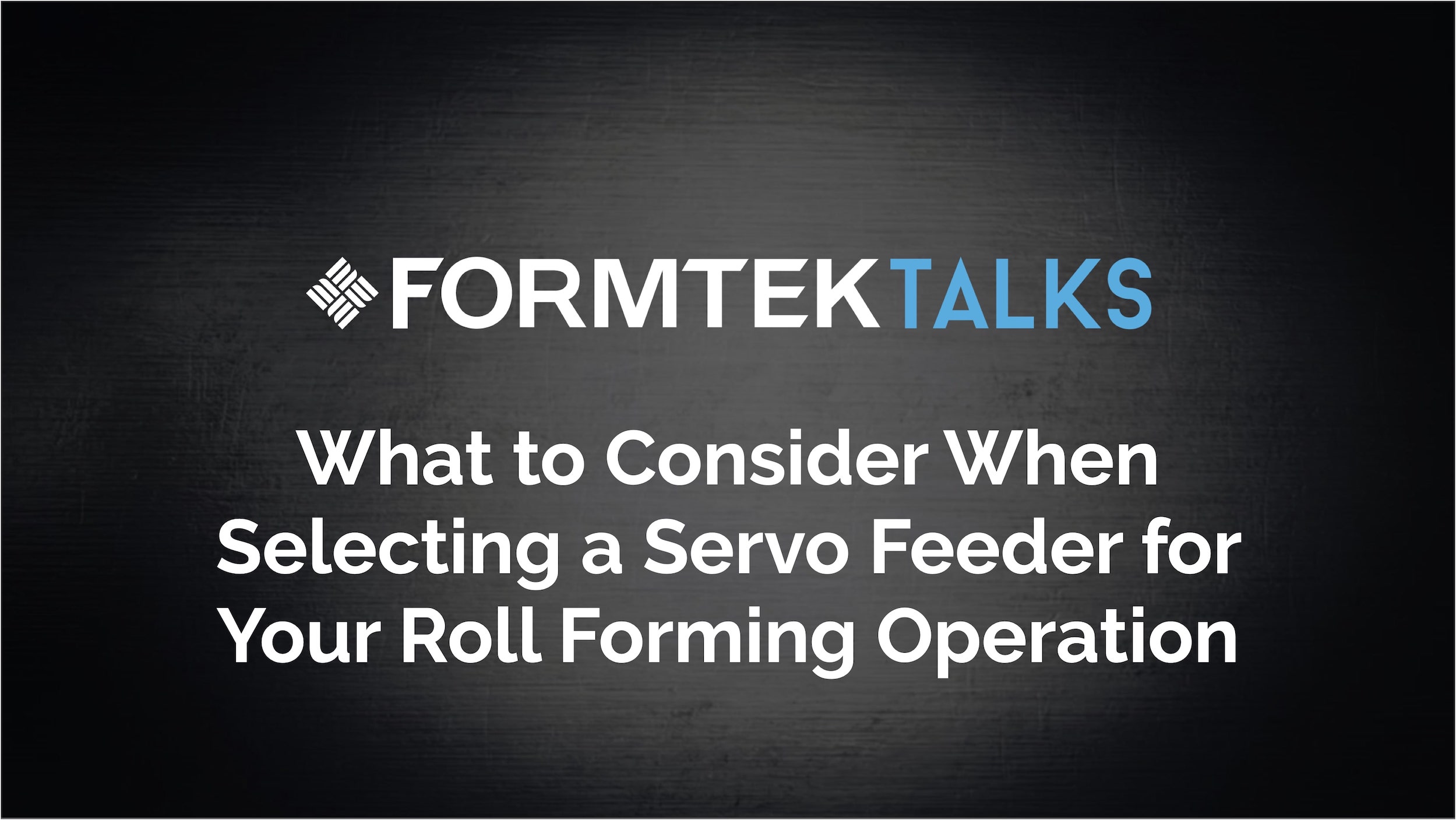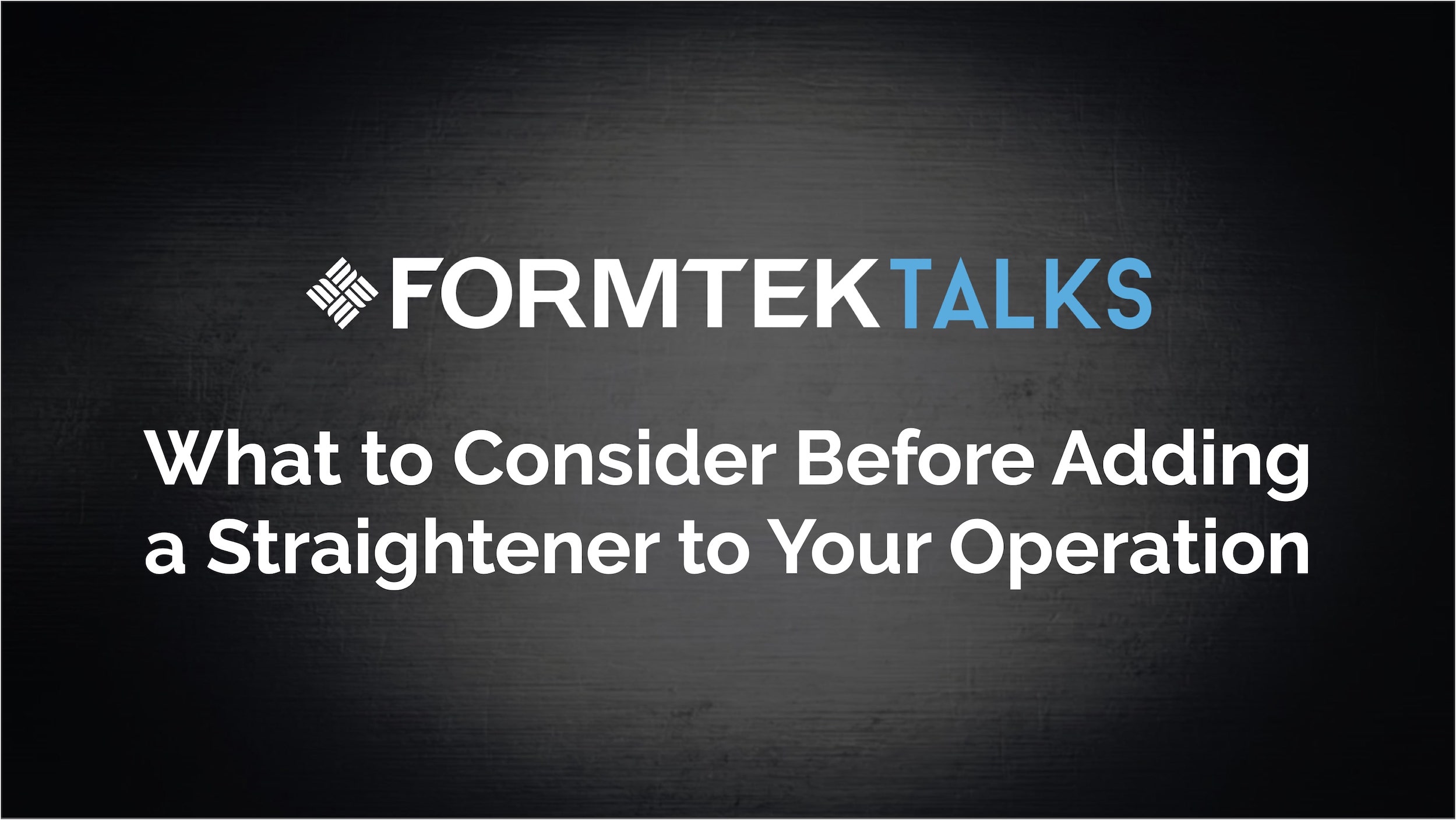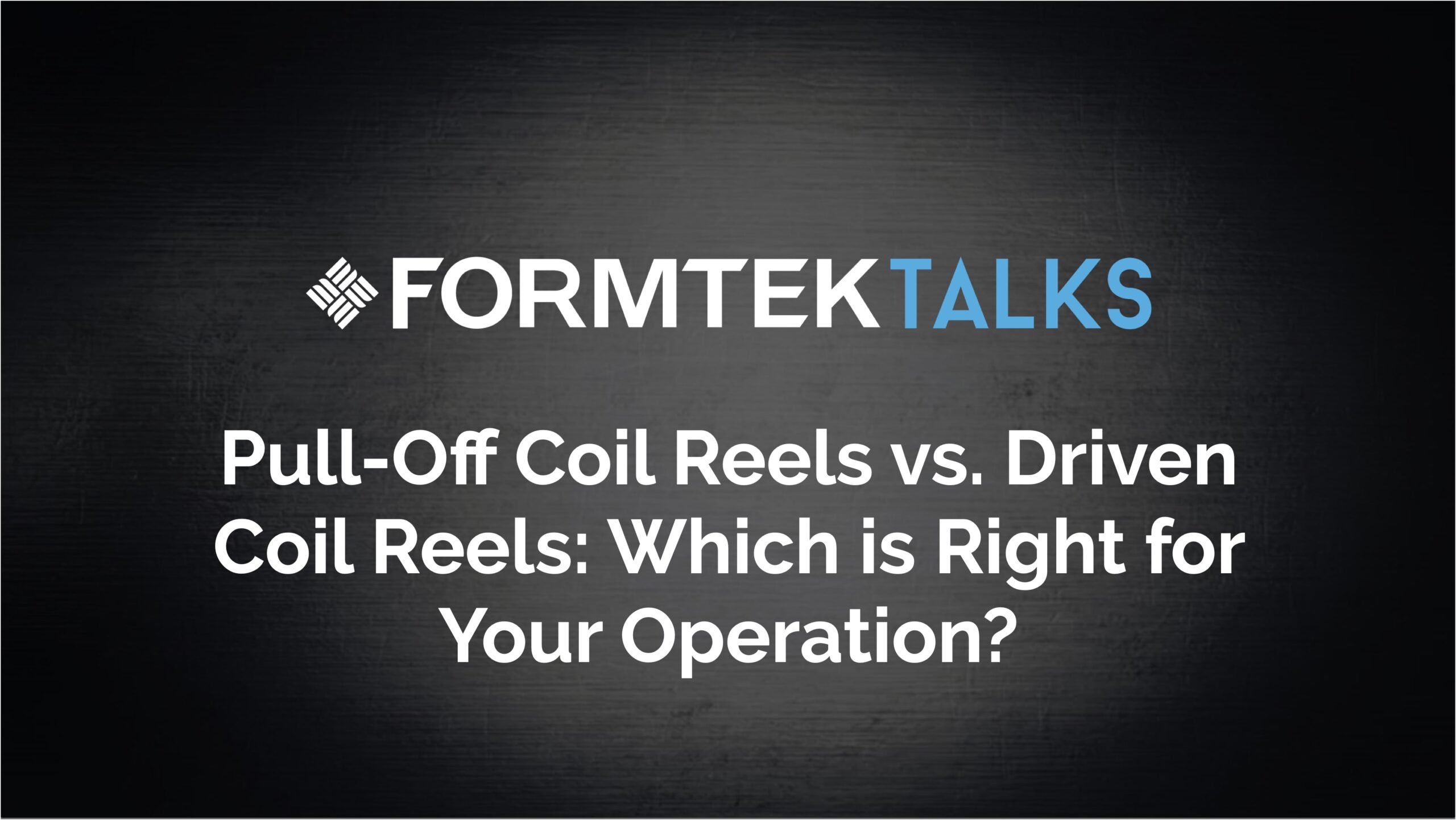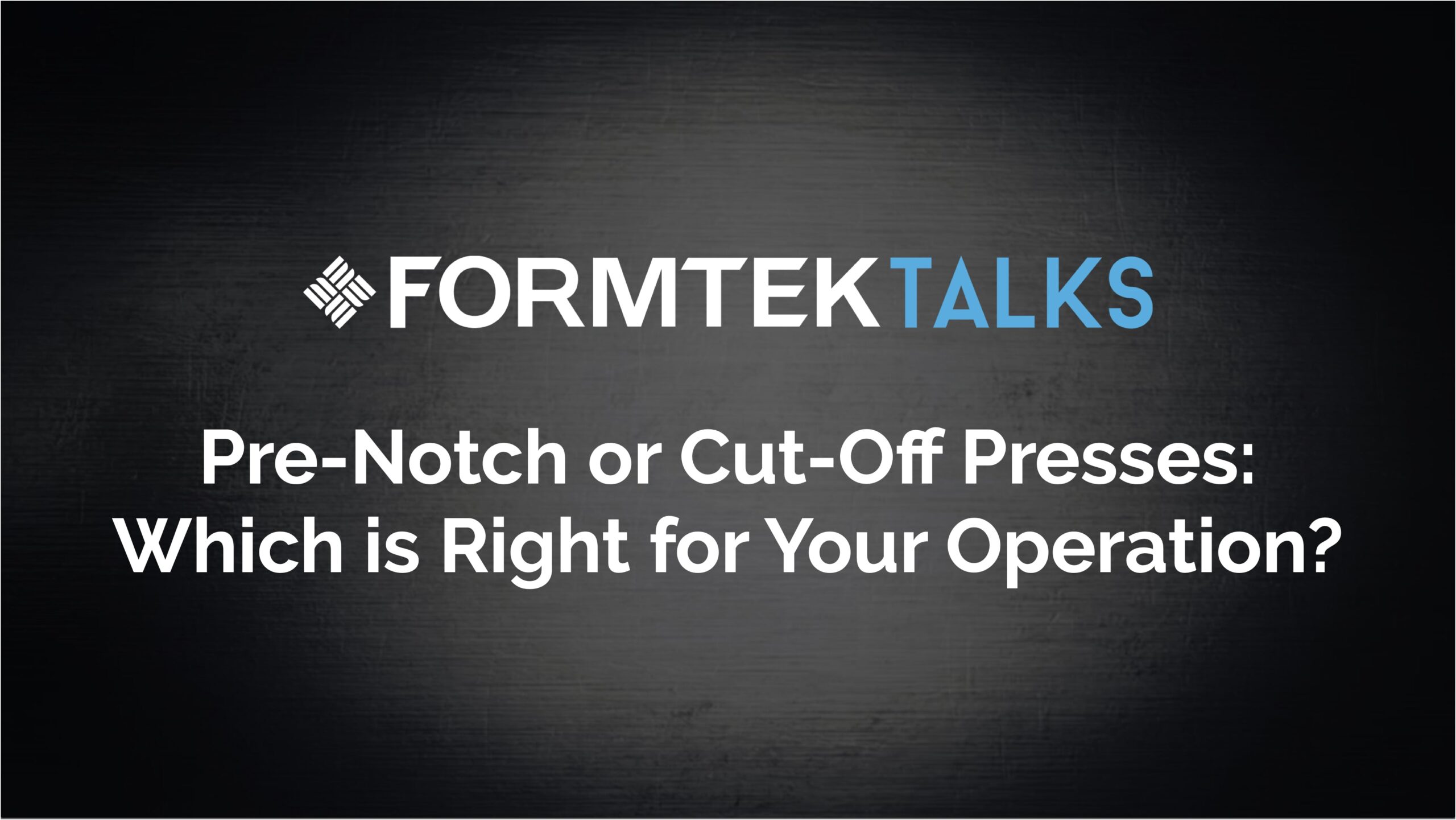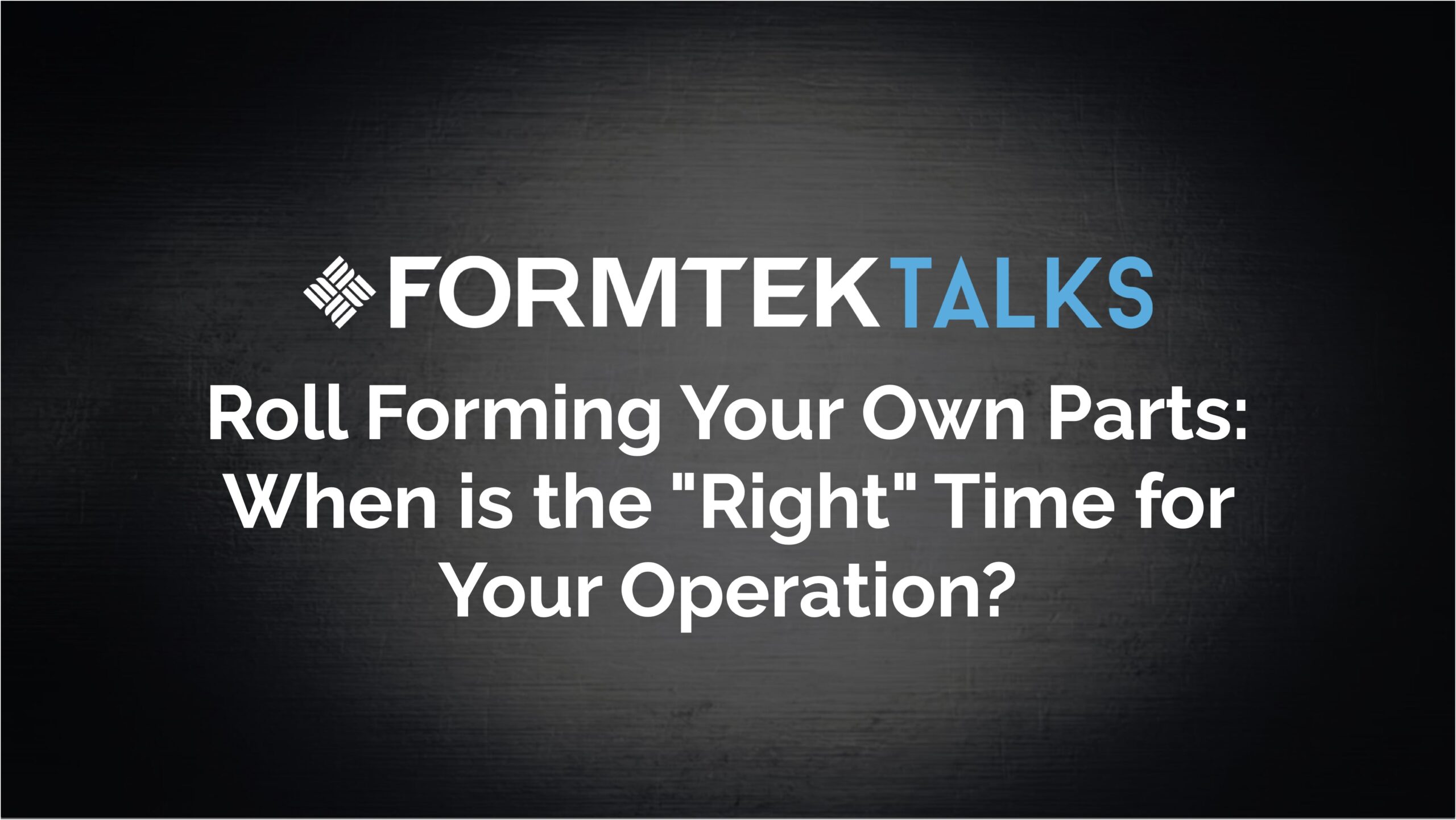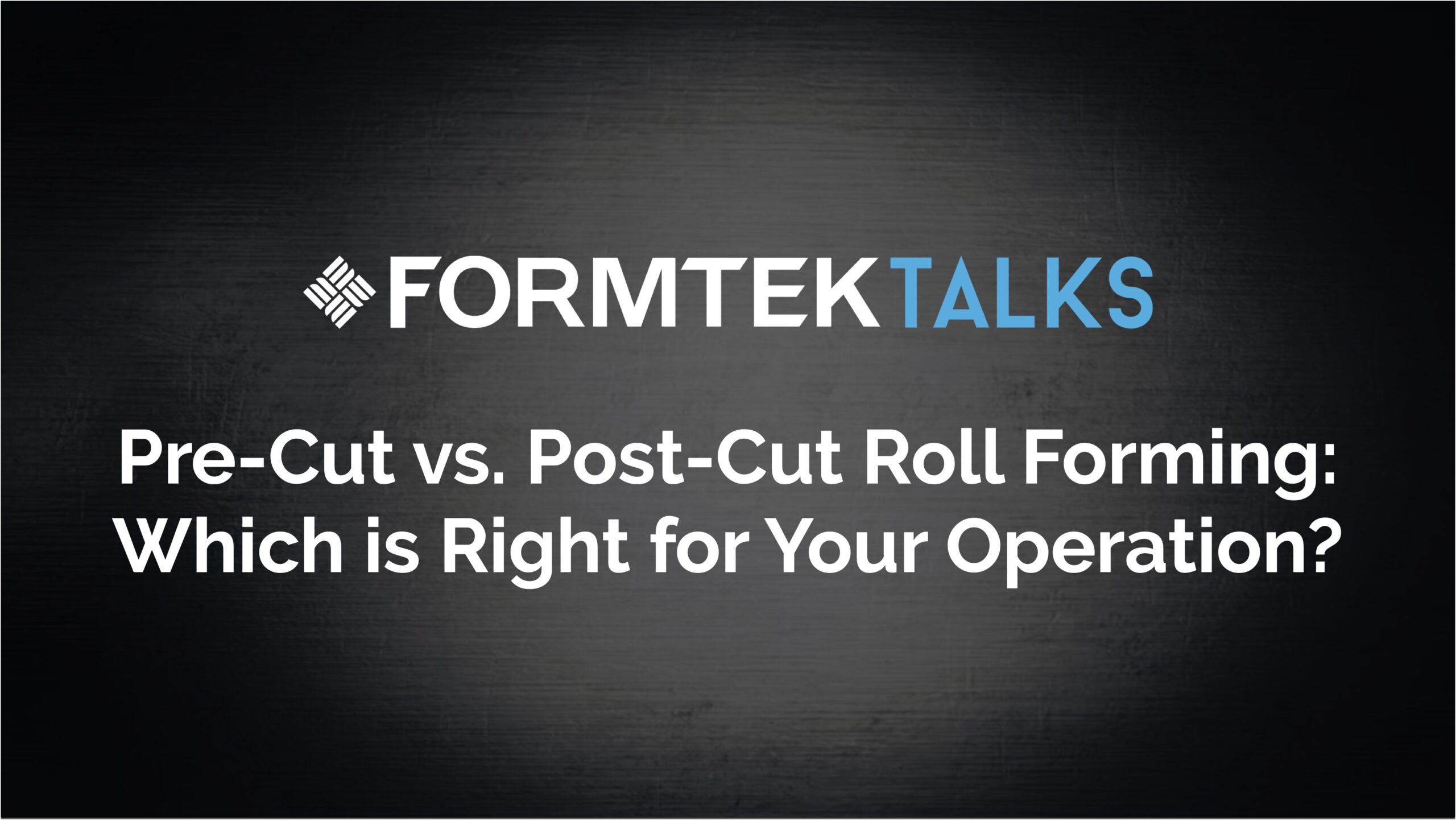Welcome to Formtek Talks — where we discuss the topics that matter most to the metal forming and fabrication industry as you look for ways to improve your operations.
In this episode of Formtek Talks, Brian Kopack is joined by Kevin Enos, and Charlie Burgess and the discussion focuses on rafting. We discuss what rafting is (including the benefits and drawbacks of rafting) and why you might consider rafting for your roll forming operation. As you’ll see, rafting can significantly increase your production and profitability by dramatically reducing changeover time. But understanding all of the possibilities as it relates to rafting is key to making the decision that’s right for your operation. But that’s why Formtek is here to help as you make these evaluations. So when you’re ready, please don’t hesitate to reach out for a no-obligation, 1-on-1 consultation with a Formtek Technical Specialist — we’d love to get to know you and your operation, get a good understanding of what you’re looking to do, and see how we can help you achieve your objectives.
Meet the Panelists
Watch the Video
Listen to the Podcast
Read the Transcript

We Want Your Feedback
We’d love to hear what you think about Formtek Talks so we can make these better as we go along. Even feedback about what topics you’d like to see us tackle in future episodes would be great.
Meet the Panelists

Brian Kopack
Vice President of Sales | Formtek, Inc.
- 22 years in the metal forming and manufacturing industry
- Bachelor of Science Degree | Mechanical Engineering from Case Western Reserve University

Kevin Enos
Vice President of Sales - Midwest | Formtek, Inc.
- Over 25 years in the metal forming and manufacturing industry
- Bachelor of Science Degree – Business Management | Edison State College

Charlie Burgess
Sales & Application Engineer | Formtek, Inc.
- Over 30 years in the metal forming and manufacturing industry
- Bachelor of Science Degree | Mechanical Engineering from Youngstown State University
Watch the Video
Listen to the Podcast
Read the Transcript
Hello, my name is Brian Kopack and welcome to Formtek Talks. Today, I’m joined by Mr. Kevin Enos and Mr. Charlie Burgess of the Formtek Group. And we’re going to talk about rafting, and what rafting is, and why you want to consider rafting for roll forming.
I’ll go ahead and start. And I’ll say when we talk about rafting, basically what we’re doing is putting a group of roll stands on a raft, a steel plate raft, or a fabricated raft. And the number of stands we put on that raft can be anywhere from two, four, six, or even eight, depending on how big and how much weight we have to consider to put on that raft. And it depends on the customer’s capabilities of lifting the raft up. But we’re going to talk a little bit about the benefits of why someone would want to do this.
And Charlie, I’m going to start with you, please elaborate on why you think the main reason for rafting is required?
Rafted Roll Stands





Sure. So, the main reason I run in roll forming is actually production, maximizing your production. If you have multiple products you’re trying to make on your roll forming line, you have to do tool change in order to make the various products. The non-rafted way is you get a pull, the rolls off the shafts that make up your roll former, and then put the new rolls back on, and you have to gauge things out. So, you’ve got the proper gaps between your top and bottom roll. This all takes time. And during this time you’re no longer making production. So, if you want to maximize your production, what you can do is go into rafting, where basically you have the stands on, as Brian said, a subplate. You’ll have one set of stands on their subplate, on the roll former making production, in most cases.
Then you’ll have a secondary set of stands and subplates that are offline. And while that line is running, you can tool up that raft set. Now, when you want to change products, you still have to shut down the line, but instead of going stand by stand and taking rolls off, also you’re doing is changing out these subplates. And as Brian said, you can have four or five, six, even three subplates with rafts on it that you’re going to have to change, but that’s going to be far quicker than going stand by stand and removing the rolls.
Right. I think in some cases, we’ve done time studies where let’s say you have a 20 pass roll forming system, and you have five sets of four pass rafts. Normally, it may take you 15 minutes per stand. You’re looking at 20 stands, that’s basically five hours. Just to physically change it over. Now you have additional time in gaping those stands and starting the thread material through and adjusting. You could be seven, eight hours in that change over time. If you’re doing rafts, general rule of thumb, is we figure 15 minutes a raft. Now you’re looking at five rafts. You’re just over an hour and 15 minutes. And in theory, what really makes this system work is, you’ve changed those roll stands offline, but you’ve also got them. You’ve also got them ready. You’ve set them up.
So when you make this changeover, there’s very little tweaking that you have to do to get the raft set ready. So, in essence, you’ve gone from seven or eight hours and you’ve knocked out at least 80% of that time. So, you’re down to one or two hours and you’re back up and running. So, obviously like you said, the production requirements or the production advantages are a huge, huge benefit. And there’s ways to even make raft changing even faster. But we won’t really talk about those. But another benefit that I think is really advantageous is the fact that now your roll forming line, if you have a second set of rafts. And by the way, we have some customers who have three and four sets of complete raft sets because some of their products, they never change. So, they just keep them tooled up offline, and maybe they designate one or two of the raft sets to be what we change overall the time, but they have a third and fourth of products they never change overall.
In line with that also brings to the point of expertise of operator. It’s hard to find talent these days to be able to gap properly a set of rules. It’s a skill. A lot of times it’s a learned skill. And keeping that talent can become difficult when you have dedicated rafts, as Brian was just saying. Once you’ve gaped those rolls correctly and you never change the rolls on those spare raft sets, basically when you take that raft set off and you set it aside, you run your other product, and then you bring that raft set, excuse me, back on, it’s set up. You don’t have to do any adjustments. It’s in the same position it was the last time it ran that product.
So, the requirement for having that level of expertise in operators is gone.
Right. Yeah. The other benefit that I was going to mention was the fact that from a maintenance perspective, if you lose a bearing, if something breaks on one raft set, in theory, you have another raft set. So, you’re not necessarily down, which is a great benefit as well. If you only have one set of roll stands and something breaks you’re down until you fix it, or maybe there’s a way to minimize that, but you’re down for some period of time. So, there’s that extra advantage of having raft sets. we can talk a little bit about what ways of changing the raft sets over and predominantly it’s Bay Crane. But if some customers don’t have Bay Cranes there’s options for forklifts and there’s things that we can do to make forklifts, to make it more easy to change the rafts over with forklifts.
There’s things that we can do there. There’s also been a lot of applications where automated raft changeover systems have been developed, where there’s carts that come in and move the rafts. And this is applicable to not only roll foaming, but tube mills as well, where cart systems come in and change the rafts and move the rafts for the operator. It all comes down to the level of automation. All of that comes at a price, obviously.
Yeah, we tend to typically pick even numbers. There’s no big reason for that other than it’s simplicity. Two, four, six, eight on our smaller mills with smaller roll stands, we can get as many as six or eight stands on a raft set. On the larger mills, we tend to settle on two or four. And it’s just really weight. It’s the amount of weight that raft set has. Because now if you have eight stands, you have eight stands at tooling. You have the raft plate itself. If a customer says, “Hey, I have a Bay Crane, but it’s only five ton and this is a big line. I may be required to only have two stands on a raft, just because of weight.” If you have a forklift and you’re using a forklift way of changing the rafts over, they may say, “I can only lift 5,000 pounds with this forklift.”
So, then even on a smaller mill, we may go to a four pass raft, because we can get the weights down. Now obviously, the more rafts you have and if you’re figuring 15 minutes a raft to change a raft over, it takes you a little bit longer, but compared to changing a roll stand over, it still saves you a lot of time because you can… Essentially you’re changing that roll stand over in 15 minutes and you got 20 of them. It can take a while.
Right. Another thing to understand is, there are times where we’ve been able to retrofit the rafting method to older mills. It’s not only limited to brand new mills. It tends to be more cost effective if we’re doing it on a brand new mill, but we can retrofit older mills with raft sets. It’s not 100% guaranteed. We can do it every single time, because there’s certain mill designs that it’s just not easily possible to do that or it becomes really costly to do it. But if you’re talking about Yoder roll formers and style, and obviously QBW style, we can retrofit old end styles with rafts and usually make that work where a customer can buy another set of rafts.
So now they’ll have two to interchange in and out. Something else to think about when it comes to the rafting is maintaining the raft and keeping things clean. I mentioned that if something breaks down, obviously if you have another raft set, you can pull it over, but cleaning the raft, it can begin to make sense where you can have a raft changeover area. And in doing something like that, you could have a wash station where you could wash that raft down. You could get all the mill scale and grease and gunk off it, so that you can… It makes it easier for the operator to change those rolls out offline separately, and put new rolls back on it. And now things are clean and easy for them to work with. So, there’s something else that you can do offline.
Yeah. Currently with our rafts, the big thing with the raft is you have to be able to disengage what I’ll call the drive mechanical from… You have to be able to disassemble that to some degree. And we’ve developed methods that make that a little bit easier so that you’re not necessarily grabbing a wrench or anything to break that apart. Also, just as a safety precaution, we always make our rafts where they bolt onto the base, but there’s hydraulic lifts or hydraulic locks. There’s all sorts of features there that we can add. But usually, the simplest thing is just to put a bolt in and give a guy an air ratchet and he can buzz that in five seconds.
And now we’re locking the raft down to the base and it can’t really come up. Now, you could argue that the weight of the raft, it’s not really going to come up, but from safety’s sake, it’s probably always a good thing to lock them back down to the base. Something else to think about though is, with our raft sets, obviously alignment with regard to the center line of the product or center line of the process. We do have key ways in our rafts that we keep that alignment very, very tight. It doesn’t go off. And the keys are chamfered so that it’s easy to get the rafts on and off. So that’s something important to keep in mind that we have to do with raft sets so that there’s a positive location, so it doesn’t affect the product being run. So, we do take care of those things. It’s built into the rafting process, but it’s something to consider, especially if you’re retrofitting.
So, that’s actually a very good question. In most cases, we like the rafts to always have its home based on, if this is pass one through four, it always sits in that area, one through four, and then pass five through eight… And it’s appropriate area. The tooling will dictate that, because you can’t put… If you tool it up with passes one through four and then five through eight, you can’t put five through eight in the space of one through four because the tooling won’t let you… That won’t work. So, you have to keep that in its correct chronological order. Now, there are cases where you can… If you have a 20 pass mill, you don’t have to utilize all 20 passes. You could run a product that only needs 12. Where do you put those rafts on now?
Do you put them at the raft position one or do you start at raft position three? Because that’s all you need. In theory, when we align those rafts, they get aligned in the position that they’re in. So the best, most accurate place for it to go is in back into that position spot. We’re very accurate on machining our keys. There is some tolerance band there. So, if you do move a raft that’s in position three into position one, you’re going to have a small deviation. And we have measured as much as anywhere from two to 10,000s. Now, depending on the type of product you’re making, that may not make a world of difference at all. But what’s more important to understand is, obviously you want the alignment from raft to raft to be as good as possible, but what’s even more important is alignment from pass to pass.
And if that raft has so many passes on it, that’s never changing. So, that’s really the… That in essence is our cushion factor that we… Passes one through four or if it’s one through eight, if that’s how many passes we have on that raft. Those passes are aligned to that raft and they can’t go go back. Now, your transition from one raft to another raft and tooling, because it’s in a different position on the mill bed, that could affect your overall tolerance. But usually it’s very small. It’s very small. But again, when we align it in theory, if you had a perfect key, it would always be right. But we all know there’s manufacturing tolerances. And in some cases on very long mills, we may have three or four beds that are all keyed together. And when you look at all keys added up and all the key ways, you can have from one end to the mill to another 40,000s.
And when we align those rafts in those positions, we’ll clean that 40,000s up so that it’s only plus or minus two from shaft to shaft. But it’s when you move that into a different, a position, that’s where you could get into a difference.




